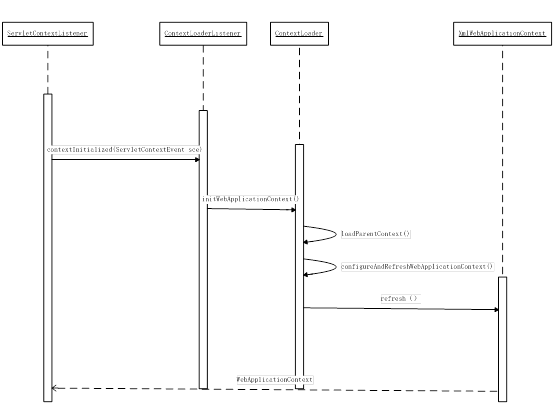1、典型配置
Spring MVC的一个典型配置如下:
<context-param>
<param-name>contextConfigLocation</param-name>
<param-value>classpath:spring-context.xml</param-value>
</context-param>
<listener>
<listener-class>org.springframework.web.context.ContextLoaderListener</listener-class>
</listener>
<servlet>
<servlet-name>test</servlet-name>
<servlet-class>org.springframework.web.servlet.DispatcherServlet</servlet-class>
<init-param>
<param-name>contextConfigLocation</param-name>
<param-value>classpath*:config/test-servlet.xml</param-value>
</init-param>
<load-on-startup>1</load-on-startup>
</servlet>
<servlet-mapping>
<servlet-name>test</servlet-name>
<url-pattern>/</url-pattern>
</servlet-mapping>2、上下文的启动及初始化过程

在这个启动过程中看到系统加载是依赖web容器的servletContextListener来触发的,这个listener的触发会在如下时候:
当Servlet 容器启动或终止Web 应用时,会触发ServletContextEvent 事件,该事件由 ServletContextListener 来处理。在 ServletContextListener 接口中定义了处理ServletContextEvent 事件的两个方法。
1) contextInitialized(ServletContextEvent sce) :当Servlet 容器启动Web 应用时调用该方法。在调用完该方法之后,容器再对Filter 初始化,并且对那些在Web 应用启动时就需要被初始化的Servlet 进行初始化。
2)contextDestroyed(ServletContextEvent sce) :当Servlet 容器终止Web 应用时调用该方法。在调用该方法之前,容器会先销毁所有的Servlet 和Filter 过滤器。
所以spring会在web容器启动的时候借助这个监听器来创建它的上下文,而这个上下文的创建其实就是一个ico容器的初始化过程。而这个上下文初始化的过程同时也会把这个ServletContext给设置上,以供后面的WebApplicationContext来获取web容器级别的全局属性。
先看下这个创建的XmlWebApplicationContext上下文的类继承关系:

它的refresh过程其实是在AbstractApplicationContext完成的,如下代码:
当Servlet 容器启动或终止Web 应用时,会触发ServletContextEvent 事件,该事件由 ServletContextListener 来处理。在 ServletContextListener 接口中定义了处理ServletContextEvent 事件的两个方法。
1) contextInitialized(ServletContextEvent sce) :当Servlet 容器启动Web 应用时调用该方法。在调用完该方法之后,容器再对Filter 初始化,并且对那些在Web 应用启动时就需要被初始化的Servlet 进行初始化。
2)contextDestroyed(ServletContextEvent sce) :当Servlet 容器终止Web 应用时调用该方法。在调用该方法之前,容器会先销毁所有的Servlet 和Filter 过滤器。
所以spring会在web容器启动的时候借助这个监听器来创建它的上下文,而这个上下文的创建其实就是一个ico容器的初始化过程。而这个上下文初始化的过程同时也会把这个ServletContext给设置上,以供后面的WebApplicationContext来获取web容器级别的全局属性。
先看下这个创建的XmlWebApplicationContext上下文的类继承关系:

它的refresh过程其实是在AbstractApplicationContext完成的,如下代码:
public void refresh() throws BeansException, IllegalStateException {
synchronized (this.startupShutdownMonitor) {
// Prepare this context for refreshing.
prepareRefresh();
// Tell the subclass to refresh the internal bean factory.
ConfigurableListableBeanFactory beanFactory = obtainFreshBeanFactory();
// Prepare the bean factory for use in this context.
prepareBeanFactory(beanFactory);
try {
// Allows post-processing of the bean factory in context subclasses.
postProcessBeanFactory(beanFactory);
// Invoke factory processors registered as beans in the context.
invokeBeanFactoryPostProcessors(beanFactory);
// Register bean processors that intercept bean creation.
registerBeanPostProcessors(beanFactory);
// Initialize message source for this context.
initMessageSource();
// Initialize event multicaster for this context.
initApplicationEventMulticaster();
// Initialize other special beans in specific context subclasses.
onRefresh();
// Check for listener beans and register them.
registerListeners();
// Instantiate all remaining (non-lazy-init) singletons.
finishBeanFactoryInitialization(beanFactory);
// Last step: publish corresponding event.
finishRefresh();
}
catch (BeansException ex) {
// Destroy already created singletons to avoid dangling resources.
destroyBeans();
// Reset 'active' flag.
cancelRefresh(ex);
// Propagate exception to caller.
throw ex;
}
}
}@Override
protected void loadBeanDefinitions(DefaultListableBeanFactory beanFactory) throws BeansException, IOException {
// Create a new XmlBeanDefinitionReader for the given BeanFactory.
XmlBeanDefinitionReader beanDefinitionReader = new XmlBeanDefinitionReader(beanFactory);
// Configure the bean definition reader with this context's
// resource loading environment.
beanDefinitionReader.setEnvironment(this.getEnvironment());
beanDefinitionReader.setResourceLoader(this);
beanDefinitionReader.setEntityResolver(new ResourceEntityResolver(this));
// Allow a subclass to provide custom initialization of the reader,
// then proceed with actually loading the bean definitions.
initBeanDefinitionReader(beanDefinitionReader);
loadBeanDefinitions(beanDefinitionReader);
}/** Default config location for the root context */
public static final String DEFAULT_CONFIG_LOCATION = "/WEB-INF/applicationContext.xml";
/** Default prefix for building a config location for a namespace */
public static final String DEFAULT_CONFIG_LOCATION_PREFIX = "/WEB-INF/";@Override
protected String[] getDefaultConfigLocations() {
if (getNamespace() != null) {
return new String[] {DEFAULT_CONFIG_LOCATION_PREFIX + getNamespace() + DEFAULT_CONFIG_LOCATION_SUFFIX};
}
else {
return new String[] {DEFAULT_CONFIG_LOCATION};
}
}if (this.context == null) {
this.context = createWebApplicationContext(servletContext);
}protected WebApplicationContext createWebApplicationContext(ServletContext sc) {
Class<?> contextClass = determineContextClass(sc);
if (!ConfigurableWebApplicationContext.class.isAssignableFrom(contextClass)) {
throw new ApplicationContextException("Custom context class [" + contextClass.getName() +
"] is not of type [" + ConfigurableWebApplicationContext.class.getName() + "]");
}
return (ConfigurableWebApplicationContext) BeanUtils.instantiateClass(contextClass);
}protected Class<?> determineContextClass(ServletContext servletContext) {
String contextClassName = servletContext.getInitParameter(CONTEXT_CLASS_PARAM);
if (contextClassName != null) {
try {
return ClassUtils.forName(contextClassName, ClassUtils.getDefaultClassLoader());
}
catch (ClassNotFoundException ex) {
throw new ApplicationContextException(
"Failed to load custom context class [" + contextClassName + "]", ex);
}
}
else {
contextClassName = defaultStrategies.getProperty(WebApplicationContext.class.getName());
try {
return ClassUtils.forName(contextClassName, ContextLoader.class.getClassLoader());
}
catch (ClassNotFoundException ex) {
throw new ApplicationContextException(
"Failed to load default context class [" + contextClassName + "]", ex);
}
}
}# Default WebApplicationContext implementation class for ContextLoader.
# Used as fallback when no explicit context implementation has been specified as context-param.
# Not meant to be customized by application developers.
org.springframework.web.context.WebApplicationContext=org.springframework.web.context.support.XmlWebApplicationContext
也就是说spring的mvc默认上下文就是XmlWebApplicationContext ,验证了我们上面对这个类的分析。























 1710
1710











 被折叠的 条评论
为什么被折叠?
被折叠的 条评论
为什么被折叠?








